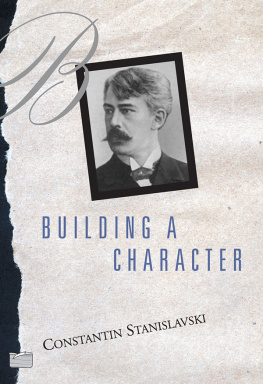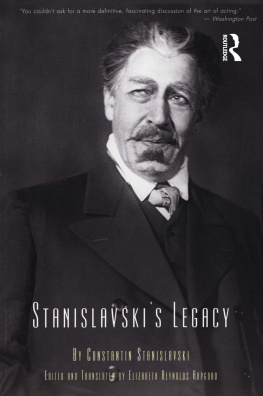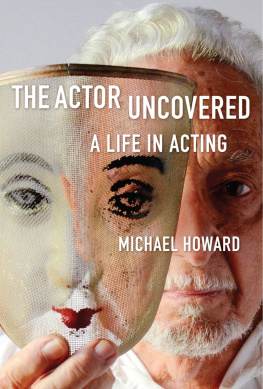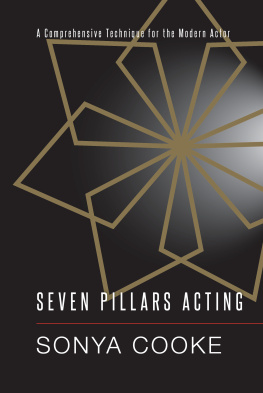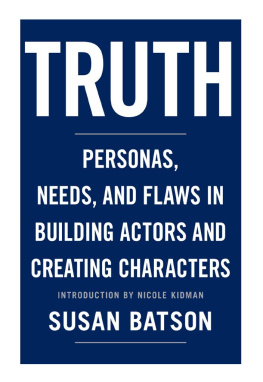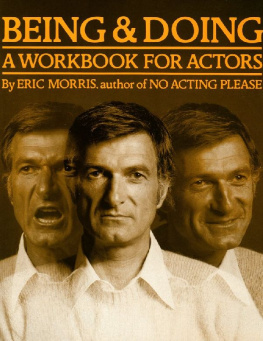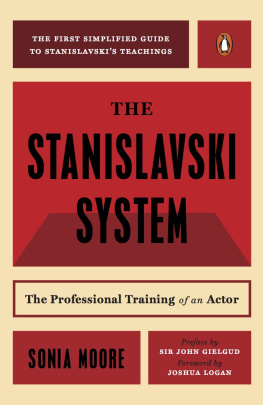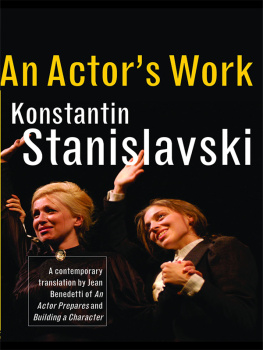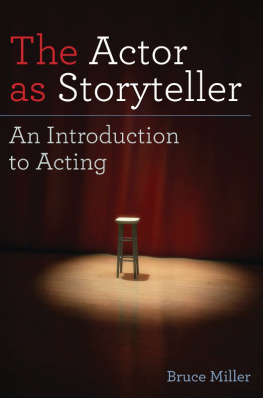The Acting Trilogy
An Actor Prepares explores the inner preparation an actor must undergo in order to explore a role to the full. In this volume, Sir John Gielgud said, this great director found time to explain a thousand things that have always troubled actors and fascinated students.
Building a Character discusses the external techniques of acting: the use of the body, movement, diction, singing, expression, and control.
Creating a Role describes the preparation that precedes actual performance, with extensive discussions of Gogols The Inspector General and Shakespeares Othello . Sir Paul Scofield called Creating a Role immeasurably important for the actor.
These three volumes belong on any actors short shelf of essential books.
Constantin Stanislavski
Building A Character
Translated by
Elizabeth Reynolds Hapgood
A Theatre Arts Book
Routledge
NEW YORK AND LONDON
A Theatre Arts Book
Published by
Routledge
711 Third Avenue
New York, NY 10017
Routledge is an imprint of the Taylor & Francis Group.
Copyright 1936 by Theatre Arts, Inc,
Copyright 1948 by Elizabeth R. Hapgood
Copyright Renewed 1964 by Theatre Arts, Inc.
All rights reserved under Pan-American Copyright Union
Copyright under Pan-American Copyright Union
All rights reserved. No part of this book may be reprinted or reproduced or utilized in any form or by any electronic, mechanical, or other means, now known or hereafter invented, including photocopying and recording, or in any information storage or retrieval system, without permission in writing from the publishers.
Text reset, 2003
Paperback ISBN 0878309829
Contents
An Actor must work all his life, cultivate his mind, train his talents systematically, develop his character; he may never despair and never relinquish this main purposeto love his art with all his strength and love it unselfishly .
CONSTANTIN STANISLAVSKI
AS FAR BACK as 1924 my husband, Norman Hapgood, and I discussed with Stanislavski the possibility of publishing the results of his experience as an actor and trainer of actors in the foremost acting company of this century. But in the years immediately following this first conversation various matters contributed to prevent this great innovator from carrying out his desire. He was too absorbed by the responsibilities of his work in the Moscow Art Theatre, of he was not only co-founder and co-director, with Nemirovich-which Danchenko, but also one of the principal actors. His own Opera Studio, where he was working out the application of his acting techniques to operatic performance with the object of achieving a complete union of the music, the words and the action, also took much of his time and energy. A third inhibiting factor was Stanislavskis own temperament. His creative and artistic genius was never fully satisfied; it urged him on to the very day of his death to search for, to test, to choose new approaches to the art of acting, so that he hesitated to sum up any conclusions as final. He always hoped to find a better path to his high goal. Moreover he was fearful lest his written record might assume the aspect of some unalterable grammar, of rigid rules, of a kind of Bible. The thing that finally persuaded him to share his results by means of the printed word with artists throughout the world was the argument that others might receive some stimulus from them to strike out into new paths of their own.
So in 1930, when Stanislavski, after a serious illness in Russia, had come to Southern France on a leave of absence from the Art Theatre to be near my husband and me, the time came to cast into final form the long prepared book. At that stage Norman Hapgood, who had been both an editor and a drama critic, urged him to put into one volume both aspects of his methodthe inner preparations of an actor and the external technical means of bringing a character to life before an audience. In the first drafts worked out on the Riviera the two parts were side by side.
Subsequently Stanislavski returned to Russia to take up his work once more. He was no longer able to act, but he continued to direct new productions and he went on with his writing. Many months later he sent me a manuscript of book length. Because he had lacked the time and strength to edit all his material, and also because he believed its inclusion in one volume would further delay the book as well as make it too bulky, he had decided to limit it to the inner preparations of an actoror of any artist dealing with the creation of a character. It was published by Theatre Arts, Inc., under the title An Actor Prepares in 1936two years before it even appeared in Russia.
In letters to me and in the course of a visit to him in 1937 Stanislavski told me about the sequel to An Actor Prepares which is this present book. It would include, he said, the chapters drafted in Southern France and others which he showed me. He also let me look at his Promptbook for Othello , which he had written out in France in order to guide a production at the Art Theatre he was prevented from overseeing personally. He felt that this manuscript might likewise be of interest to the English-speaking theatre.
But neither of these manuscripts was at that time in a form satisfactory to him. He continued to work on them until his death the following year. Shortly afterward the Second World War intervened, making communications more difficult even before Russia became involved in 1940. Although his family cabled me that manuscripts were on their way, only fragments appeared and it wasnt until considerably after the war was over that I received a bulk of the material in this volume. Last autumn Robert M. MacGregor, who had acquired the book publishing department of Theatre Arts which he formerly managed, planned to publish Building a Character as a part of the commemoration of the fiftieth Anniversary of the founding of the Moscow Art Theatre and the tenth of Stanislavskis death, but the news that more material and later versions were on their way caused him to delay publication. The postponement also allowed further editing which consisted mainly of choosing among the various versions of given chapters which had come to hand.
In this continuation of An Actor Prepares , the scene is again the same dramatic school with its own auditorium and stage, a part of a permanently established theatre. Here are the same students, who represent a characteristic group of young actorsthat argumentative young fellow Grisha; Sonya, who is both pretty and vain about it; her admirer, the clowning Vanya; Maria, with her womans intuition; the introspective pair, Nicholas and Dasha; the well-coordinated, acrobatic Vasya; and above all Kostya, the ex-stenographer who because he knows shorthand can make a detailed record of the lessons in a sort of actors diary. Ever searching, ever throwing himself ardently into any project that shows promise of further development, he is possibly a picture of Stanislavski himself many years before. The teacher is of course Stanislavski, the mature actor, thinly disguised as Tortsov, the director of the school and the theatre. He is assisted by Rakhmanov, who is full of inventiveness in driving home the points made by Tortsov, in dividing visual aids, in conducting drill.
The emphasis in this book, as in Stanislavskis My Life in Art (now also published by Mr. MacGregor) and An Actor Prepares , is on acting as an art and art as the highest expression of human nature. His continual return to the study of human nature is the Antean touch which distinguishes what has come to be known as the Stanislavski system. It is the basis of all his theories and the reason they were always being modified slightly; with each return to the study of human beings something new was learned. As he says of his method in this book:It is not a hand-me-down suit that you can put on and walk off in; or a cook book where all you need to find is the page and there is your recipe. No, it is a whole way of life.

